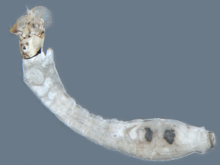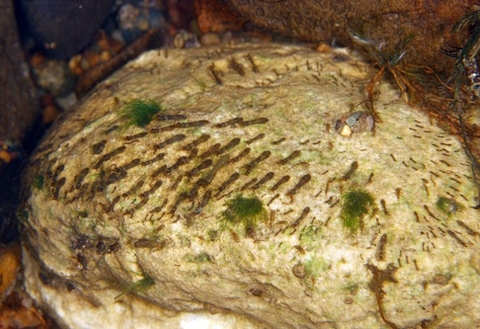Quick facts
- Black flies bite people and many different animals.
- Black flies are active spring through summer and bites are most common during spring.
- Wear a long-sleeved shirt, pants and a hat to avoid black fly bites.
- Repellents are not always effective but may provide some help.
How to identify black flies
Black flies are also called gnats or buffalo gnats. Thirty species of black flies occur in Minnesota. All species are very similar in appearance to each other.
Adults
- Small (1/16 inch)
- Stout, dark colored, rounded back
- Broad wings, short legs
- Few hairs on body
Larvae
- Worm-like and legless
- End of abdomen is enlarged
- Two fan-like structures near the head
Biology of black flies
- Eggs are laid in rivers, streams and other running water:
Black fly larvae in a river - Directly onto the water, or
- On the leaves of aquatic plants and objects.
- Once they hatch, the larvae attach themselves to stones, grass, branches, leaves and other objects under the water.
- Larvae develop under water for 10 days to several weeks depending on species and water temperature.
- Pupae last for a week, before transforming into adults.
- Adults live for about three to six weeks.
- Both males and females feed on flower nectar for flight energy.
- Only females bite to take a blood meal.
- Most adults can fly about 10 miles from their breeding source.
- They can be carried much further on air currents.
Simulium venustum is an aggressive biter that develops in smaller streams.
- Adult females feed on humans and other animals.
- It has one generation in the spring (April to early June).
Simulium johannseni is a moderately aggressive biter that develops primarily in the Crow, South Fork Crow and Minnesota rivers.
- Adult females feed on both mammals and birds.
- It has one generation in the spring at about the same time as S. venustum.
Simulium meridionale can bite people but is less aggressive than the species described above.
- Adult females feed on mammals and birds.
- It develops in the Minnesota, South Fork Crow and Crow rivers.
- It is abundant May to July, producing three to six generations.
Simulium luggeri is usually a nuisance by flying around your head.
- Adult females feed on humans and other mammals.
- It develops primarily in the Mississippi and Rum rivers (smaller numbers also occur in the Minnesota and Crow rivers).
- There are five to six generations a year. They are active from May to October.
Simulium vittatum is not known to bite people. It prefers horses, cattle and other large mammals.
- It develops in smaller streams as well as large rivers.
- It occurs throughout spring and summer.
Black fly bites
Black flies can be a serious problem because they bite. When black flies are active they can develop into very large swarms.
- Black flies use blade-like mouthparts to slash the skin and feed on blood.
- Bites are concentrated on exposed areas of skin, especially along the hairline, feet, ankles and arms.
- Bites can produce reactions from small red spots and little or no irritation to a lot of irritation and swelling.
- Sensitivity varies from person to person.
- Black flies can attack many different domestic and wild animals, including birds.
- In extreme circumstances, black fly bites have killed animals through severe blood loss.
Sometimes black flies are nuisances by just swarming around people without biting. Because they like to swarm around heads, they might crawl into the nose, ears, eyes and mouth.
Behavior and habits
- Black flies are most active a couple of hours after sunrise and a couple of hours before sunset.
- They are most active on calm days and in sheltered areas (wooded areas).
- They are less of a nuisance on windy days and in open areas.
- Black flies are attracted to dark colors such as navy blue.
Can black flies spread disease?
In Minnesota, black flies are not known to spread diseases. In other parts of the world, they can spread serious diseases.
How to protect yourself from black flies
It is very difficult to prevent black flies from biting, especially when they are in large numbers.
There is no control measure to reduce black flies in an area since they can fly from up to 10 miles away or more.
To reduce black fly bites try these suggestions:
- Avoid areas with high black fly populations, such as lowlands, areas with dense vegetation or sheltered and shady areas.
- Avoid being outside when black flies are most active, generally at dawn and dusk.
- Wear white or brightly colored clothing. It is less attractive to the flies than dark-colored clothing.
- Cover up bare skin with shoes, socks, long sleeves shirts, long pants and hats.
- Wear a head net, similar to a bee keepers veil. You can find them in outdoor stores and gardening catalogs.
- Insect repellents, such as DEET, are not always effective but may provide some relief.
Reviewed in 2019



